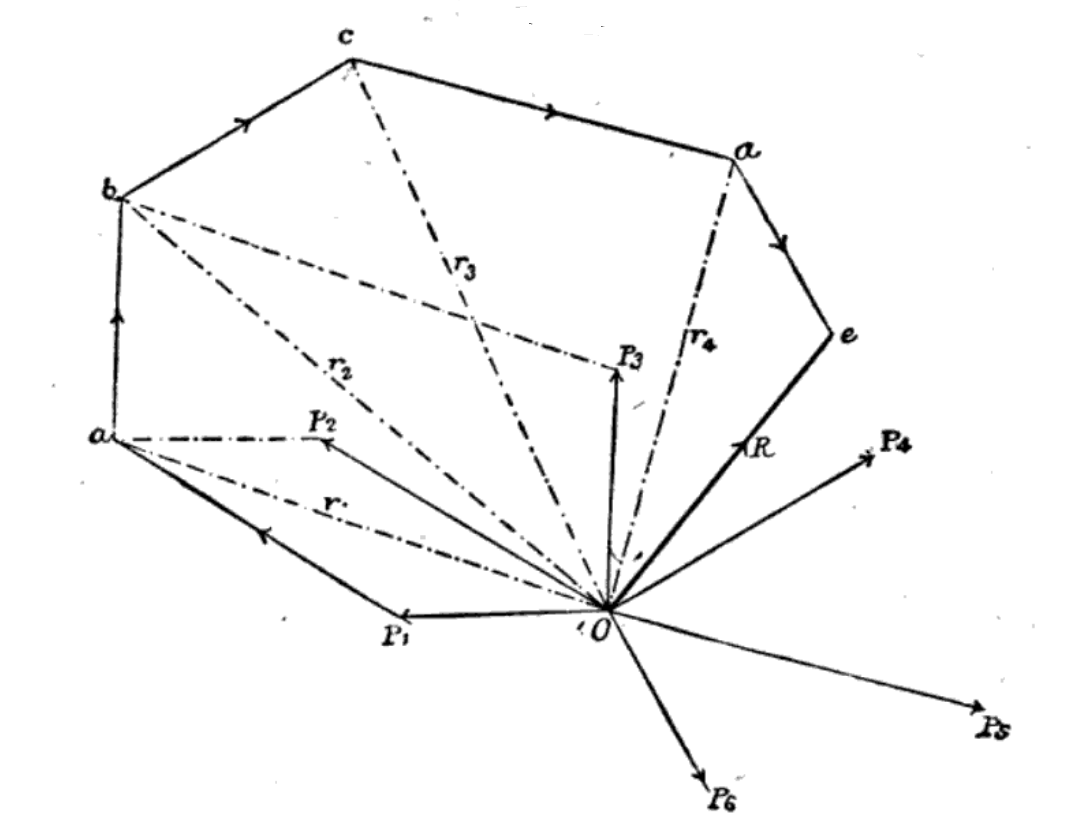Graphic Statics on:
[Wikipedia]
[Google]
[Amazon]
In a broad sense, the term graphic statics is used to describe the technique of solving particular practical problems of
 To graphically determine the resultant force of multiple forces, the acting forces can be arranged as
To graphically determine the resultant force of multiple forces, the acting forces can be arranged as
statics
Statics is the branch of classical mechanics that is concerned with the analysis of force and torque (also called moment) acting on physical systems that do not experience an acceleration (''a''=0), but rather, are in static equilibrium with ...
using graphical means. Actively used in the architecture of the 19th century, the methods of graphic statics were largely abandoned in the second half of the 20th century, primarily due to widespread use of frame structures of steel
Steel is an alloy made up of iron with added carbon to improve its strength and fracture resistance compared to other forms of iron. Many other elements may be present or added. Stainless steels that are corrosion- and oxidation-resistant ty ...
and reinforced concrete
Reinforced concrete (RC), also called reinforced cement concrete (RCC) and ferroconcrete, is a composite material in which concrete's relatively low tensile strength and ductility are compensated for by the inclusion of reinforcement having hig ...
that facilitated analysis based on linear algebra. The beginning of the 21st century was marked by a "renaissance" of the technique driven by its addition to the computer-aided design
Computer-aided design (CAD) is the use of computers (or ) to aid in the creation, modification, analysis, or optimization of a design. This software is used to increase the productivity of the designer, improve the quality of design, improve c ...
tools thus enabling the architects to instantly visualize form and forces.
History
Markou and Ruan trace the origins of the graphic statics to da Vinci andGalileo
Galileo di Vincenzo Bonaiuti de' Galilei (15 February 1564 – 8 January 1642) was an Italian astronomer, physicist and engineer, sometimes described as a polymath. Commonly referred to as Galileo, his name was pronounced (, ). He was ...
who used the graphical means to calculate the sum of forces, Simon Stevin
Simon Stevin (; 1548–1620), sometimes called Stevinus, was a Flemish mathematician, scientist and music theorist. He made various contributions in many areas of science and engineering, both theoretical and practical. He also translated vario ...
's parallelogram of forces and the 1725 introduction of the force polygon and funicular polygon by Pierre Varignon
Pierre Varignon (1654 – 23 December 1722) was a French mathematician. He was educated at the Jesuit College and the University of Caen, where he received his M.A. in 1682. He took Holy Orders the following year.
Varignon gained his first ex ...
. Giovanni Poleni used the graphical calculations (and Robert Hooke
Robert Hooke FRS (; 18 July 16353 March 1703) was an English polymath active as a scientist, natural philosopher and architect, who is credited to be one of two scientists to discover microorganisms in 1665 using a compound microscope that ...
's analogy between the hanging chain and standing structure) while studying the dome of the Saint Peter's Basilica in Rome (1748). Gabriel Lamé and Émile Clapeyron studied of the dome of the Saint Isaac's Cathedral with the help of the force and funicular polygons (1823).
Finally, Carl Culmann
Carl Culmann (10 July 1821 – 9 December 1881) was a German structural engineer.
Born in Bad Bergzabern, Palatinate region, Rhenish Palatinate, in modern-day Germany, Culmann's father, a pastor, tutored him at home before enrolling him at the m ...
had established the new discipline (and gave it a name) in his 1864 work ''Die Graphische Statik''. Culmann was inspired by preceding work by Jean-Victor Poncelet on earth pressure and ''Lehrbuch der Statik'' by August Möbius. The next twenty years saw rapid development of methods that involved, among others, major physicists like James Clerk Maxwell and William Rankine. In 1872 Luigi Cremona introduced the Cremona diagram
The Cremona diagram, also known as the Cremona-James Clerk Maxwell, Maxwell method, is a graphical method used in statics of trusses to determine the forces in members (graphic statics). The method was developed by the Italian mathematician Luigi ...
to calculate trusses, in 1873 Robert H. Bow established the "Bow's notation" that is still in use.
Concepts
Polygon of forces
 To graphically determine the resultant force of multiple forces, the acting forces can be arranged as
To graphically determine the resultant force of multiple forces, the acting forces can be arranged as edges
Edge or EDGE may refer to:
Technology Computing
* Edge computing, a network load-balancing system
* Edge device, an entry point to a computer network
* Adobe Edge, a graphical development application
* Microsoft Edge, a web browser developed by ...
of a polygon by attaching the beginning of one force vector to the end of another in an arbitrary order. Then the vector value of the resultant force would be determined by the missing edge of the polygon. In the diagram, the forces P1 to P6 are applied to the point O. The polygon is constructed starting with P1 and P2 using the parallelogram of forces ( vertex a). The process is repeated (adding P3 yields the vertex b, etc.). The remaining edge of the polygon O-e represents the resultant force R.
In the case of two applied forces, their sum ( resultant force) can be found graphically using a parallelogram of forces.
References
Sources
* * * * Structural analysis {{engineering-stub